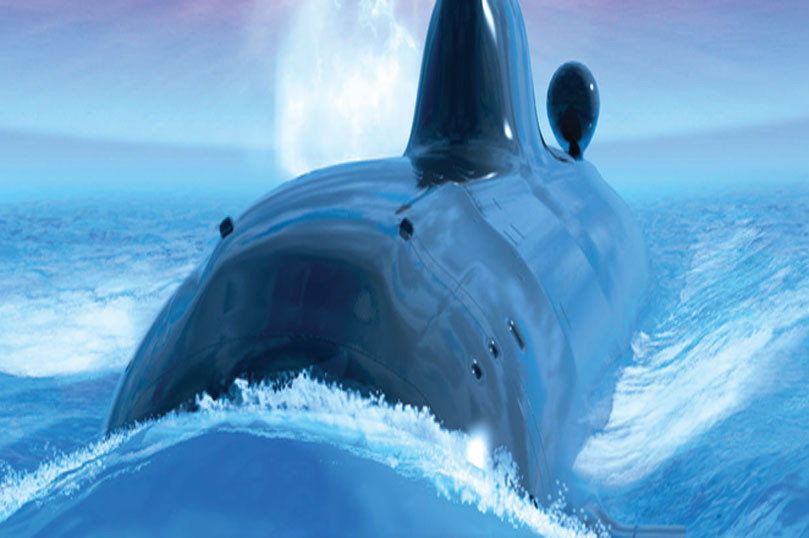opens in a new window opens in a new window
opens in a new window opens in a new window
opens in a new window opens in a new window
opens in a new window opens in a new window
opens in a new window opens in a new window
opens in a new window
 India and Pakistan are stalemated in a war that India launched to “remove the threat of terrorism, once and for all.” But India’s early successes have stalled, and with the coming spring, the tide may turn against them. A small but powerful group of Indian senior military officers and civilian security officials have decided to strike at China, Pakistan’s backer and India’s recent enemy in the Littoral Alliance War.
India and Pakistan are stalemated in a war that India launched to “remove the threat of terrorism, once and for all.” But India’s early successes have stalled, and with the coming spring, the tide may turn against them. A small but powerful group of Indian senior military officers and civilian security officials have decided to strike at China, Pakistan’s backer and India’s recent enemy in the Littoral Alliance War.
Girish Samant, until recently the captain of Chakra, discovers hints of the far-reaching conspiracy and reaches out to an old enemy, the only person he can trust, Jerry Mitchell. Enjoy this excerpt of Fatal Thunder by Larry Bond.
1
SHOCK WAVE
9 March 2017
1100 EST
CNN
They’d changed the studio’s backdrop to a map of the Kashmir region that slowly morphed into a Google Earth landscape that then zoomed in on the specific area where the detonation had been reported. The network was still waiting for satellite images of the actual explosion site, so the graphics team had marked the spot with a small animated mushroom cloud. Occasionally the background would go to split screen, with one half devoted to the map, and the other showing photos of the Kashmiri countryside, some taken prewar, others since India’s invasion of Pakistan six months ago.
CNN had its best national-security correspondent, Jane Bergen, anchoring the desk. She was a known commodity, with dark hair framing a square face and black-rimmed glasses.
“Good morning and welcome to CNN’s continuing coverage of the nuclear explosion in Kashmir. It’s been just over twenty-four hours since the detonation of what is now agreed was a nuclear weapon of over one hundred kilotons in Kashmir, a disputed territory and the object of so much recent fighting between India and Pakistan. India is at the center of a public firestorm of accusations, but denies any knowledge of or responsibility for the blast.
“Our entire CNN team is covering different aspects of the developing crisis, which is complicating the already difficult and tense peace negotiations between the two warring countries in Geneva, Switzerland.
“Sources in the U.S. intelligence community have confirmed to CNN that the apparent location of the blast is a major base and training camp for Lashkar-e-Taiba, a large Islamic terrorist organization operating in Afghanistan and Pakistan. LeT is responsible for dozens of attacks in India, including the infamous Mumbai hotel siege in 2008 that killed a hundred and sixty-four people and wounded hundreds more. During India’s recent participation in the Littoral Alliance war with China, the terrorist group attacked the Indian naval bases at Visakhapatnam and Rambilli, damaging the Indian Navy’s nuclear ballistic missile submarine Arihant.
“One of India’s publicly stated goals in this fourth war with Pakistan is to, quoting India’s defense minister, ‘remove, once and for all, the threat of Islamic terrorist attacks against India launched from inside Pakistan’s borders.’
“Our first guest this hour is Dr. Mark Ulrich, from the Council on Nuclear Weapons. He is an expert on the design and construction of atomic bombs, and has an update for us.”
Ulrich was a heavyset man, with an untidy appearance. His hair was mussed, and he needed to straighten his tie. “We’ve concluded, based on seismographic readings from several different sources, that the weapon was larger than we originally estimated, approximately one hundred and fifty kilotons, about ten times the size of the Hiroshima blast.”
“Does this increased size of the blast change the casualty estimate your group published last night?”
Ulrich riffled through the notes in front of him. “Of course, those were early estimates, but the biggest driver is still the lucky fact that the area is sparsely populated, and isolated by high valley walls, which run southeast to northwest.”
He zoomed in on the satellite image. “This small village of Nullaa is closest to camp’s location, and has probably been annihilated, since it’s just a few kilometers from ground zero, and lies near the floor of the valley, in line with the blast effects. The uneven terrain complicates calculating the effects at any given place, but any structure within, say, three miles will be virtually destroyed, light damage and injuries could happen as far away as ten miles.”
The landscape background stopped moving, and two circles appeared on the map three and ten miles from ground zero. Ulrich pointed out almost a dozen villages and hamlets within the affected area. “There will be a lot of broken windows and minor injuries, even in the local capital, Muzaffarabad.”
He sighed. “It’s remote area, which is good, because it means few people live there, but because it’s so remote, it will be hard to get help in to them.”
“And of course, the whole region is a war zone,” Bergen added. “Although there’s been a cease-fire since October. What about the fallout?” she asked.
The scientist sighed again. “It’s obvious from the seismic readings that it was a ground burst, so hundreds of tons of material have been vaporized, irradiated, and lifted to high altitudes. There will be a lot of fallout. The north-northwesterly prevailing winds will carry it across the parts of Kashmir controlled by Pakistan and India, then into western China. Although Xinjiang Province in China is thinly settled, many parts of Kashmir in the path of the fallout are populated and farmed. The Himalayas will prevent the cloud from spreading south into the densely populated parts of India.
“Our meteorologist will have better estimates later today of the fallout’s path, based on the current and predicted weather over the next few days.”
He shook his head. “Our estimate of casualties from the explosion hasn’t changed significantly, because we really have very little demographic information on the region. Our guess, and it’s only that, is that several hundreds, at most a thousand souls were killed by the initial blast. That includes many who will not be able to receive medical help for their injuries in time. There may be twice that many injured who will recover, but there will be tens of thousands, possibly many more, who will suffer long-term health effects from the fallout-induced radiation.”
9 March 2017
2130 Local Time
U.S. Navy Support Facility
Diego Garcia, Indian Ocean
It had been a long flight from Nebraska, but the crew barely had time to eat while the aircraft was refueled. By the time they got back to the flight line, the ground crew had the plane ready for engine start.
They’d brought over thirty people with them to Diego Garcia from their home base in the U.S., but for this flight, there’d be the bare minimum complement—only enough crew to safely operate the aircraft. That was to minimize any exposure while they flew through the fallout cloud.
There was an atmosphere of urgency, but not haste. The sooner they got to the area and collected their samples, the better. Not only were the radioactive remnants of the blast decaying and dispersing by the minute, there were a lot of people who were waiting for answers.
The WC-135 was officially code-named “Constant Phoenix,” but the crew just referred to it by the tail number, “67.” There were only two of them in the air force. The other bird, back home at Offutt Air Force Base, was “93.” A modified C-135, itself derived from the long-obsolete Boeing 707, it carried devices to capture samples of the atmosphere and any fallout particles that might be present.
The big white and gray aircraft, call sign “Windsock,” began to taxi. Nearby, two F-15 fighter escorts came to life and fell in at a respectable distance behind. The U.S. already had overflight rights in Pakistan and had obtained permission from India for this mission, but its course would take Windsock into a shaky cease-fire zone, and right up to the edge of Chinese territory.
Windsock’s transponder would identify it as a U.S. Air Force plane, and both the Pakistani and Indian air defenses would be notified before Windsock entered their airspace. The mission would not violate anyone’s borders, but the Air Force was taking no chances. An E-3 Sentry radar plane and a RC-135 Rivet Joint SIGINT aircraft were already in position to watch and listen for any reaction from Indian or Chinese air defense.
Aerial tankers would orbit off the coast of Pakistan, over the northern Arabian Sea. Windsock would need to refuel during its eleven-hour mission, and the tankers would also keep a flight of four more F-15s on station over the water topped off and ready until Windsock cleared the area and was headed south again.
10 March 2017
1000 Local Time
INS Circars, Eastern Naval Command Headquarters
Visakhapatnam, India
Vice Admiral Badu Singh Dhankhar tried to project an air of calm, in both his tone and his words. “No, Captain, we’re not going to cancel the operation. We owe it to everyone who’s supported us up to this point.”
“Admiral, please, it’s not just the press. That’s bad enough, but the prime minister says there will be a formal inquiry.”
“Of course, but we both know that’s all for show. Everyone is blaming India for the Kashmir incident, and after all, you are the head of the navy’s nuclear weapons program.”
Dhankhar sighed and sat down, but not at his desk. Instead, he used a chair next to Captain Kapil Asrani, and poured more tea. Asrani was taller than the admiral, and younger than Dhankhar by fifteen years, but the admiral wore his rank well. His authority and experience were well known. He’d distinguished himself as a junior officer in the Indo-Pakistani War of 1971. Now almost seventy, and commander of India’s Eastern Naval Command, he was widely respected and liked, a pillar of the fleet.
He paused, as if in calm contemplation, but internally gauging Asrani’s level of agitation. Too much depended on this man. The captain’s office was in charge of developing nuclear warheads for India’s submarine-launched missiles: the Sagarika ballistic missile that would go aboard Arihant, and the Nirbhay cruise missile that could be used by any submarine, and also by aircraft and from ground launchers. Both programs were a long way from being successful, though. The technical challenges were ferocious.
Asrani was smart and well educated, and Dhankhar believed him to be a patriot, but he was also a worrier. The Indian military was in shock over the nuclear explosion in Kashmir, and the entire world was blaming India for it, so it was no surprise that the captain was on edge.
Finally, Dhankhar said, “Tell them your office had nothing to do with the Kashmiri explosion, that the Indian Navy had nothing to do with the explosion, and of course that you had no personal knowledge of the explosion, before the event.” Dhankhar smiled reassuringly. “The first two are certainly true, and the last is only partially false.”
The captain listened, then nodded—reluctantly, but agreeing. “I’ve told bigger lies than that in the past months. You’re right, Admiral. There’s nothing there that leads back to us, and we really don’t know exactly what happened in Kashmir. We can safely continue with the project.”
“Continue, and finish more quickly,” Dhankhar added firmly. He saw Asrani’s surprised expression. “There really is nothing in Kashmir that will lead to us, but an investigation’s questions and probing might accidentally trip over our project. Also, the explosion’s made everyone nervous, and nervous people make mistakes.” He directed a piercing look at Asrani, who nodded again.
Dhankhar said, “Orlav’s been working long hours, but he can do more. We are well into the project, and there have been no surprises or problems. Everyone knows what needs to be done to finish. I think we can be ready within a month.”
The admiral stood and ordered, “Come back to me tomorrow morning with a firm completion date if we abandon the schedule and work at full speed.” Dhankhar saw the captain open his mouth to object, but cut him off. “The quicker we finish, the less exposure and the less risk of accidental discovery. By the time the formal investigation is under way, we’ll be done.”
“Yes, Admiral, I’ll give you a detailed answer tomorrow morning,” Asrani acknowledged, standing. “But what about Chakra’s refit?”
“After you give me our completion date, I’ll go to the yard supervisor and tell him that the refit is being cut short because of ‘heightened tensions’ after the Kashmir explosion. The way everyone’s reacting, that’s certainly believable. I’ll brief Captain Jain myself.”
11 March 2017
1100 Local Time
INS Circars, Engineering Hall, Ship Building Centre
Visakhapatnam, India
Captain Girish Samant found most of his staff in the conference room, huddled around a television tuned to a news channel. The announcers were babbling about the first eyewitness reports from the area, and displaying aerial photos. “Back to work! This has nothing to do with us!”
Samant’s tone was sharp, almost venomous, and the staffers fled. There were two doors into the conference room, and nobody used the door nearest Samant. In fact, nobody even looked directly at the captain.
Scowling, Samant walked quickly over to the television and turned it off, stopping the offensive chatter. He had no patience for people so easily distracted. They had more important things to do. The program office was behind on a number of mandatory reports, and Samant had called in his entire staff to work on Saturday to catch up. Many of the engineers had complained bitterly about his mad insistence on working extra hours just to keep an arbitrary schedule. This is why it takes India thirty years to design and build a submarine, he fumed.
Samant remembered the papers in his hand. He’d been trying to find one of the financial analysts, to review the cost estimates for the propulsion system, and his search had discovered not only one office empty, but all of the offices, and that had led the Indian captain here.
The analyst’s name was Singh. Samant had to refresh his memory by looking at the report. He’d been in charge of the project for only two days, and was still learning names.
He would have much preferred remaining aboard Chakra, but he could see why Vice Admiral Dhankhar had assigned him here. The reassignment had been unexpected. By rights, he should have remained captain of the sub for another six months before being transferred ashore. He wondered if his predecessor had committed some horrendous blunder, or if Dhankhar had just become fed up with the project’s lack of progress.
The Advanced Submarine Program was India’s second attempt to design and construct a nuclear submarine. The first program had created Arihant, now in service. The second boat, Aridhaman, was under construction, so it could certainly be considered a success, but the follow-on submarine design was taking much too long. By rights, the new program, building on the experience of the first, should have progressed much more quickly. But it wasn’t, as far as he could see.
His mind returned to the meeting with Vice Admiral Dhankhar. It had been straightforward enough—a review of the progress on Chakra’s refit, which had drifted into a discussion of the ongoing truce talks and the course of the war with Pakistan.
India had planned to eliminate Pakistan as a threat—remove her nuclear capability and destroy the bases in Pakistani territory that supported the terrorist attacks against India. They’d almost succeeded before the weather had closed in and ended the campaign until the spring.
Whatever the government might claim were the reasons for agreeing to truce talks, Samant and the rest of the military knew that the Indian Army had stopped advancing. Pakistani resistance had stiffened as Chinese support increased and the weather worsened. They were inside Pakistani territory, but not far enough. The enemy army, largely intact, still faced them, and their nuclear weapons were still a threat.
The most common scenario for the Kashmir incident held by Indian military personnel, discounting aliens, was that some of the Pakistani nuclear weapons had fallen into the hands of, or been handed over to, Lashkar-e-Taiba, and that somehow, perhaps in preparing a weapon for a future terrorist attack, someone had crossed the blue and red wires.
Dhankhar and Samant had been discussing the frightening implications of that hypothesis when the admiral had suddenly declared, “The real problem is China.”
Samant had immediately agreed, of course. It was universally understood among the military that with China now providing more support to Pakistan, and with the shock of the initial invasion having worn off, a resumption in fighting would find India facing a much more dangerous opponent, and a harder task.
The admiral stated firmly, “If we could prevent the Chinese from backing Pakistan, we could certainly win the military campaign and force the Pakistanis to agree to our terms.”
Samant didn’t like to disagree with admirals. Dhankhar was right, but wishing for China to go away was a waste of effort. China was helping Pakistan, and would continue to do so. That was a reality that India had to live with. Finally, he replied, “Wouldn’t that just widen the war, sir? And this time, India would be fighting alone. We may have missed our chance, sir. Maybe giving the Pakistanis back their territory in return for assurances…”
“And we’ll be right back where we started, Captain,” Dhankhar replied harshly. “I can’t accept that, after so much blood and effort, halfway to our goal.”
Dhankhar had ended the meeting shortly after that, and two days later, Samant had received orders relieving him of command of Chakra and assigning him to be the head of the Advanced Submarine Program, designing India’s next nuclear submarine. It was a logical step in his career, if a little premature, but Samant kept asking himself if there was a connection between the two events.
Instead of putting his foot through the television screen, Samant decided to return to his office. He’d find Singh later, after he’d cooled down a little more. He didn’t mind letting the people under his command know he could get angry, but angry people could make bad decisions.
And his outburst had sent a clear message. The rest of INS Circars might be going insane. They might double the security at the main gate. They might post sentries and institute ID checks at the entrances to every building. They might even close the commissary because they were worried about terrorist attacks, but this office would not follow their example.
Back in his office, he sat down to organize his thoughts. His eyes fell on the large photograph of Chakra, hung on the center of the opposite wall, facing his desk. His new office was almost palatial, compared with the closet-sized space he’d lived and worked in aboard the submarine, but he missed it. He missed being in command of one of the most important units in the Indian Navy.
He still worried about her, too. Was all this confusion affecting the refit? He thought of phoning Jain and visiting for a few minutes, but was reluctant to call. He and Jain had never been that close. It had never seemed appropriate to Samant. Jain would be busy enough without getting a call from his former commanding officer. He might even interpret it as meddling.
Better to focus on the task at hand. Lead by example.
He left to find Singh.
11 March 2017
1700 Local Time
Visakhapatnam, India
Aleksey Petrov often ate at Akshaya’s, in the restaurant district northeast of the naval base and the dockyard. Many of the other Russians working in Visakhapatnam, or “Vizag,” ate there as well. The staff was considerate of foreign sensibilities, toning down the spices below their customary volcanic intensity, and they’d actually tried adding some foreign items to the menu. Luckily, Petrov liked pierogies, and hadn’t had the heart to tell the manager they were Polish, not Russian.
Virtually all the Russians in Vizag worked either at the naval base or the dockyard, and often met at Akshaya’s, sharing conversation—usually news from home and complaints about the heat and humidity.
Today the talk was all about work. The Russians who worked at the dockyard as technicians or consultants were in an uproar. At noon, Captain Mitra, in charge of the work on Chakra, had called everyone into the shipyard and announced that the sub’s refit was to be cut short. She had to be ready for sea in four weeks!
“‘By April tenth,’ Mitra announced,” Ivanov reported, “as if it was that easy! Admiral Dhankhar was there, too, looking as if he was afraid Mitra wouldn’t recite his speech properly.”
Anton Kulik, an electronics technician and former sonar officer, complained, “It doesn’t make sense. I’m still routing the new cabling. Some of the new components aren’t even on hand yet. Mitra says anything that can’t be finished by April tenth should just be closed up as best we can.”
“Why?” Petrov asked. He was just as puzzled as the others, but not as emotionally attached to the refit work. He worked over in the Engineering Hall as a consultant on submarine technology; that is, until this afternoon. Now he was a special advisor to Mitra.
“The heightened tensions after the Kashmir blast require Chakra to be operational as soon as possible, according to Mitra.” Ivanov sounded angry, as if he’d been insulted. “Was that the best excuse they could come up with?”
“Maybe they’re nervous about having both nuclear subs in the dockyard at the same time,” Petrov said, shrugging. “It’s not a good reason to end the refit early, but it’s easier to believe.”
“No, that doesn’t make any sense,” Suslov said, shaking his head. “The entire reason they scheduled the refit was because they knew Chakra wouldn’t play a big part in the war with Pakistan. That hasn’t changed, as far as I can see.”
Everyone at the table, Petrov included, nodded agreement. The Indian Navy had definitely wanted Chakra to be refitted. Preparations had included over a year of planning, negotiations with Russia and money spent for parts and equipment to be fitted into the sub, more money to prepare the dockyard—it would fill a book. To suddenly abandon the project like this was more than just a bad decision.
Many of the Russians intended to go back to the dockyard after dinner. “It’s long hours for me, but not as bad as Orlav,” Kulik remarked. “I’m supposed to take his dinner back to him. He’s working in the first compartment—maybe an all-nighter.”
Petrov had heard of Evgeni Orlav, a weapons technician in his forties. He was an electronics technician working on the torpedo tubes’ interface with the fire control system. “What’s he working on that’s so urgent?” he asked.
Kulik shrugged as he paid his dinner bill. “It’s something the Indians have him doing and he won’t talk about it at all. He’ll complain about his ugly wife and her enormous family all night, but he never talks shop.
“Orlav really works for Dhankhar, not Commander Gandhi. The admiral put him on the refit team, and Orlav makes his progress reports directly to the admiral. He’s either in the first compartment working on the gear aboard the sub, or he’s in one of the torpedo shops, ‘conducting tests’ he says.”
Kulik lowered his voice. “I think the Indians have a nuclear cruise missile ready to deploy, or at least test, and Orlav’s installing the interface.”
Petrov nodded. “I didn’t think their cruise missile was ready yet. But perhaps the development schedule has been moved up, and that’s why they’re cutting the refit short,” he reasoned.
Kulik was noncommittal. “That’s not the type of thing I’d want to hurry. Whatever it is, after Mitra made his announcement, the admiral pulled Orlav aside and they spoke for a while. Orlav wasn’t happy. I’m betting Dhankhar told him to get the work done and to sleep after Chakra’s finished.”
11 March 2017
1900 Local Time
Tbilisi, Georgia
Yuri Kirichenko heard the satellite phone buzz and almost snatched it from the cradle. Only one person had the number for that phone. He turned it on and said, “Jascha Churkin! So, you’re alive.”
“Just barely. I was in Ghori, just under five kilometers away, but across a small mountain from the blast. The flash and the shock wave were still beyond anything I’ve ever seen. I may start believing in God again. Most of Ghori was flattened. Since then, I’ve been traveling south and waiting for the ionization cloud to disperse. This is the first time I’ve been able to get through.”
“And your search for the missing warhead is now moot. What about the thieves?”
“I found them. Faysal is radioactive gas, but I located Jawad at Muzaffarabad, living a most un-Islamic life. He was drunk.”
“Jawad? From our escort? The short one?”
“And his friend Faysal, who Jawad said was an ‘electronics expert.’ The little thug was following us at a distance, and brought the substitute crate. He even had the correct markings on the outside.”
“Morons,” Kirichenko muttered, “and yet not. This plan was supposed to be foolproof. The warheads were worthless to the militants from Al Badr we hired. I must have explained to them three times that without the initiators, the warheads were just dead metal.”
“And you promised them some live warheads from the next batch,” Churkin added. “And they were paid handsomely, but you can’t rely on simple greed when stupidity is mixed in.”
Churkin had been responsible for security. He was a former Russian Navy special forces commando. But in addition to his impressive military skills, the navy had learned of his talent for illegal activities, ranging from bootlegging to blackmail. Kirichenko had encountered Churkin back in the nineties, out of the service and on the edge of the law. The ex-commando’s skills had been vital in ensuring first the secrecy of Kirichenko’s stolen stockpile, then its recovery, and now its transport across half of Eurasia.
Starting with their recovery from the Kara Sea, Churkin had shepherded the warheads on their long trip from northern Russia, across the Caspian Sea to Turkmenistan, Afghanistan, and then northern Pakistan, into Kashmir, where one of the six weapons had been discovered to be missing. Churkin had been forced to make sure the rest of the shipment was safe before leaving in pursuit of the thieves, but they had vanished into the landscape. By the time he’d found their trail, he was days behind and too late.
Kirichenko decided it was a good thing he hadn’t been any closer to his goal. Churkin and Kirichenko were not fast friends, but they were kindred souls working for a common purpose—massive financial reward. His loss would have been inconvenient, at least. Kirichenko privately wondered what Churkin’s plan would have been if he’d reached the LeT camp with the warhead inside.
“So why did Jawad steal one of my nuclear warheads? Did this fool Faysal think he could build his own initiator?” Kirichenko asked, almost laughing.
“No, but Faysal knew that Lashkar-e-Taiba had someone who might be able to—someone from the Khan network,” Churkin reported in a dark tone.
“Oh.” Kirichenko understood the implications instantly. A brilliant Pakistani scientist named A. Q. Khan had first helped build Pakistan’s weapon, and then created a nuclear underground network that had provided technology to Iran, Libya, and North Korea—at least. While he’d been under house arrest for a while in Pakistan, he had been freed in 2008. His network had never been dismantled.
Churkin reported, “Those two thieves walked into that Lashkar-e-Taiba camp and were paid ten times the amount for one warhead that you gave Al Badr to transport all six. Jawad was doing his best to drink his way through his half of the money.”
“Did he tell anyone else where they had obtained the warhead?” Loss of one of the six weapons was bad enough, but if the shipment had been compromised …
“Jawad said they didn’t speak to anyone else on the way, not with what they were carrying. It took them some time to reach the LeT camp after they stole the weapon, and if Jawad was telling the truth, they reached it about the same time that the rest of our shipment crossed into Indian territory. Anyone Faysal talked to is now in hell along with him. I’ve also just confirmed the remaining five have reached the coast.”
“And Jawad?” Kirichenko asked.
“Will not talk,” Churkin replied. “I solved his drinking problem.” Kirichenko could almost hear Churkin smiling.
“Then there’s nothing else to be done there. You should get into India as quickly as possible.”
“Understood,” Churkin replied. “I’ll contact you again when I’m across the border.”
12 March 2017
0820 Local Time
Director General Naval Projects, Ship Building Centre
Visakhapatnam, India
Samant looked up from the keyboard when he heard the knock. His office door was open, and Maahir Jain, Samant’s former first officer and now commander of INS Chakra, was standing in the doorway like child waiting for a parent to notice him.
He couldn’t hide his surprise—it was Sunday and he certainly didn’t expect anyone to drop by his office—but he also suddenly felt great pleasure at seeing his old executive officer, and he let that show as well.
Samant almost leapt up from behind his desk, coming around to offer his hand. “Captain Jain. It’s good to see you! Would you like some tea?” Samant pointed toward the teapot and cups but Jain waved him off.
“I cannot stay long,” he explained apologetically. “I have an appointment with Vice Admiral Dhankhar at nine.” After a moment’s hesitation, he continued, “But I wanted to come by and see how you were faring in your new assignment. The men are asking after you, as well.”
I’ll bet they are, Samant thought. He’d used a “firm, but fair” command style, emphasizing discipline and professional knowledge. He’d driven Chakra’s crew hard, and they’d performed, but they always called him “Captain,” never “Skipper.” It hadn’t bothered Samant, who found it hard to make friends. Being a captain wasn’t supposed to be a popularity contest.
As they sat, Samant asked, “Why are you meeting the admiral here and not at the headquarters building on INS Circars? And on Sunday? Is this about Chakra’s progress, or are they going to give you a third stripe, now that you’re in command?”
“You haven’t heard, then?” Jain was surprised. “About the change in the refit schedule?”
Samant, confused, shook his head. “I’ve been trying to focus on getting the program back on schedule and ignored all the bedlam. Bad as it is, I don’t see how it has much to do with what we’re doing.”
“They cut our yard period short, Cap—I mean, sir. We’re to sail on April tenth.”
“What?!” Samant was thunderstruck. He knew exactly what Chakra’s status was, as of a week and a half ago. The tenth of next month? That is insane! “Why?”
“I don’t know, sir. My main concern right now is getting Chakra ready for sea. It’s not just that the boat’s in pieces. I’ve got people on leave and in training, and if we’re going to sea, I’m already behind in arranging for torpedoes and stores…”
“But you’re not going to ask why they’ve made the change?” Samant pressed.
“I’ll let the officers with stars on their shoulders worry about why. I’ve got enough on my plate.”
That didn’t sit right with Samant, but he held his peace. If Jain had asked him to go with him to meet with the admiral and demand an explanation, he would have gone, but Jain didn’t ask.
They talked about other things: an upcoming memorial in June for the men lost on Arihant, some of whom they’d both known, and the progress, or lack of progress, of the war.
It was time for Jain to leave, and Samant tried to put as much warmth into his farewell as he had into the greeting. He did wish Jain well, even if he was worried about Chakra’s fortunes under his command. She wasn’t Samant’s boat anymore, and he had to get used to that.
Copyright © 2016 by Larry Bond and Chris Carlson
Fatal Thunder comes out May 3rd. Buy it today:
opens in a new window opens in a new window
opens in a new window opens in a new window
opens in a new window opens in a new window
opens in a new window opens in a new window
opens in a new window opens in a new window
opens in a new window






